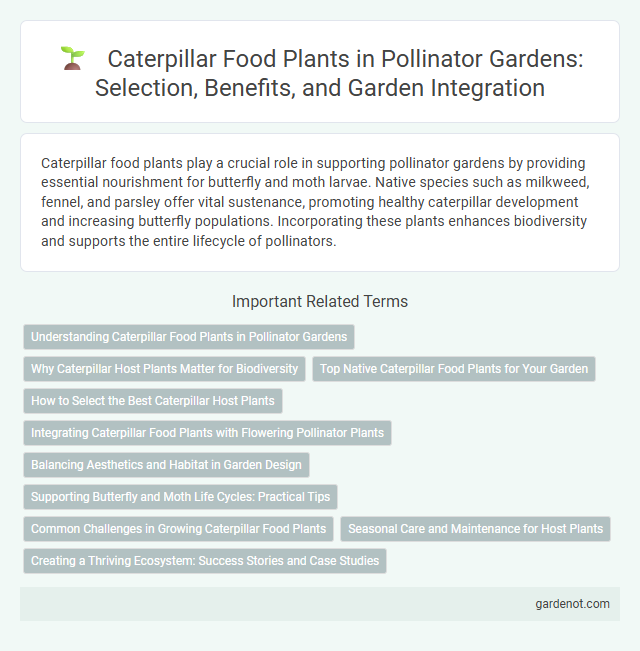Caterpillar food plants play a crucial role in supporting pollinator gardens by providing essential nourishment for butterfly and moth larvae. Native species such as milkweed, fennel, and parsley offer vital sustenance, promoting healthy caterpillar development and increasing butterfly populations. Incorporating these plants enhances biodiversity and supports the entire lifecycle of pollinators.
Understanding Caterpillar Food Plants in Pollinator Gardens
Caterpillar food plants, such as milkweed, parsley, and dill, are essential components of pollinator gardens because they provide critical nourishment for butterfly larvae during their development stages. These host plants support the life cycle of pollinators by supplying the necessary nutrients that caterpillars need to grow into healthy butterflies and moths. Incorporating a diverse range of native caterpillar food plants enhances biodiversity and helps sustain local pollinator populations.
Why Caterpillar Host Plants Matter for Biodiversity
Caterpillar host plants are essential for sustaining biodiversity by providing critical food sources that support the larval stages of many butterfly and moth species. These plants enable successful metamorphosis, which contributes to healthy pollinator populations that maintain ecosystem balance. Protecting and planting diverse caterpillar food plants in pollinator gardens enhances habitat connectivity and promotes species resilience against environmental changes.
Top Native Caterpillar Food Plants for Your Garden
Milkweed, wild cherry, and oak trees are top native caterpillar food plants essential for a thriving pollinator garden. These plants support native butterfly species like monarchs and tiger swallowtails by providing crucial nutrition during the larval stage. Incorporating a diverse range of native host plants ensures higher caterpillar survival and promotes local biodiversity.
How to Select the Best Caterpillar Host Plants
Choose caterpillar host plants by prioritizing native species that support local butterfly and moth populations, ensuring optimal larval growth and survival. Emphasize plants with high nutritional value and those preferred by target pollinator species, such as milkweed for monarch caterpillars or fennel for swallowtails. Incorporate a diverse range of host plants to accommodate various caterpillar species and promote biodiversity within the pollinator garden.
Integrating Caterpillar Food Plants with Flowering Pollinator Plants
Integrating caterpillar food plants such as milkweed, parsley, and dill with flowering pollinator plants like coneflowers and bee balm creates a balanced habitat that supports all life stages of pollinators. This combination enhances biodiversity by providing essential larval nourishment and adult nectar sources, boosting pollinator survival and reproduction rates. Strategic planting ensures continuous blooming and food availability, attracting butterflies, bees, and other beneficial insects throughout the growing season.
Balancing Aesthetics and Habitat in Garden Design
Incorporating caterpillar food plants such as milkweed, fennel, and parsley supports essential butterfly life cycles while maintaining visual appeal through diverse textures and colors. Strategically placing these host plants alongside ornamental flowers promotes a harmonious balance between functional habitat and garden aesthetics. Selecting native species tailored to local pollinators ensures ecological health without compromising beauty in garden design.
Supporting Butterfly and Moth Life Cycles: Practical Tips
Planting native milkweed, parsley, and fennel provides essential caterpillar food plants that support the complete life cycles of butterflies and moths. These host plants offer vital nutrition for larvae development, increasing survival rates and promoting biodiversity in pollinator gardens. Regularly monitoring and avoiding pesticides protects caterpillars during their vulnerable stages, fostering healthy butterfly and moth populations.
Common Challenges in Growing Caterpillar Food Plants
Caterpillar food plants, such as milkweed and parsley, often face challenges like pest infestations, fungal diseases, and fluctuating moisture levels that affect their growth and survival. Inconsistent watering and poor soil quality can lead to weakened plants, making them less appealing to caterpillars. Effective pest management and selecting native, resilient plant species improve the success rate of cultivating these essential pollinator resources.
Seasonal Care and Maintenance for Host Plants
Caterpillar food plants require regular seasonal care to ensure healthy growth and support for butterfly larvae throughout their development stages. Prune host plants in early spring to remove dead or damaged stems, promoting fresh, vigorous growth essential for feeding caterpillars. Maintain consistent soil moisture and monitor for pests during peak growth months to prevent plant stress and optimize habitat quality in the pollinator garden.
Creating a Thriving Ecosystem: Success Stories and Case Studies
Native milkweed species serve as essential caterpillar food plants in pollinator gardens, significantly boosting monarch butterfly populations by providing vital habitat and nutrition. Case studies demonstrate that integrating diverse host plants like fennel and parsley supports multiple caterpillar species, enhancing biodiversity and ecosystem resilience. Successful pollinator gardens report a 40% increase in caterpillar survival rates when native food plants are strategically planted to create continuous food sources.
Caterpillar food plant Infographic

 gardenot.com
gardenot.com